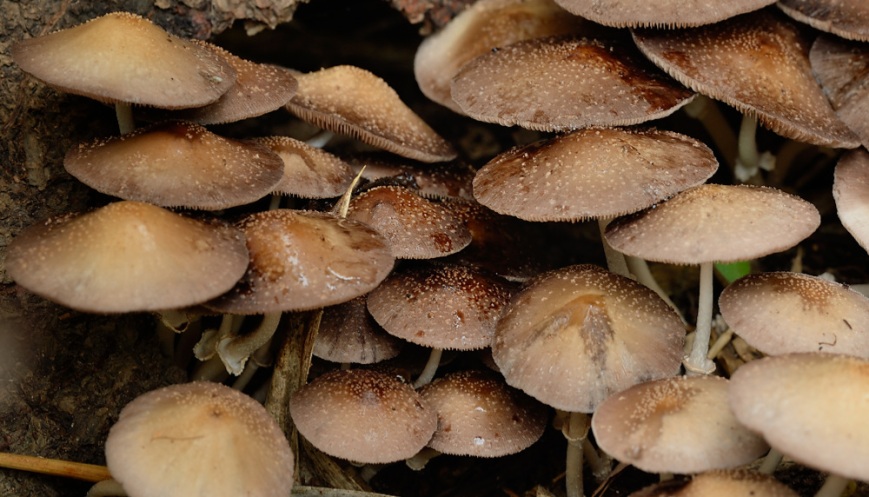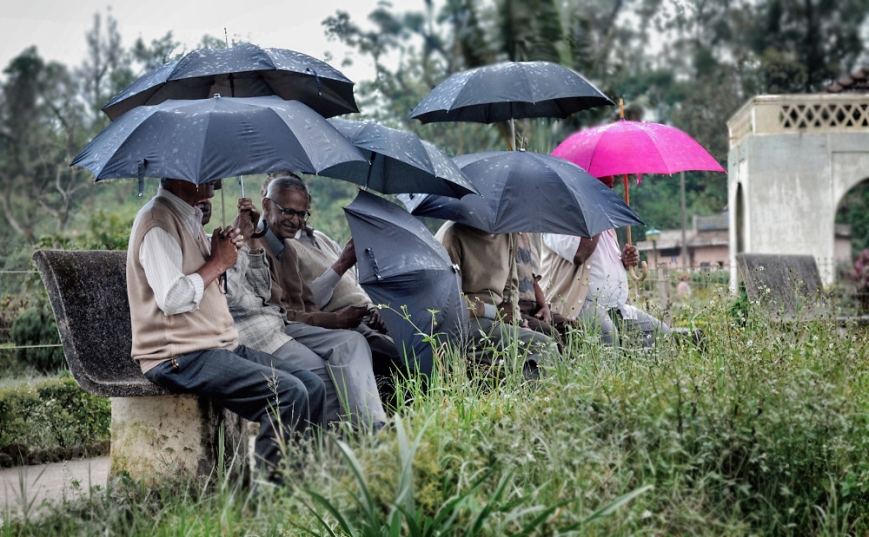Rain rain go away, Come again another day. Rain rain go away, Little Johnny wants to play… I get reminded of this nursery rhyme whenever I see my photographer friends who are scared to take their cameras out in the rainy season. Rains create wonderful opportunities for photography, so unpack your camera and other photography equipment and get ready to click.

I am reminded of a small trip that I took in the southern part of India on my motorcycle. I had a Nikon FM10 with a Nikkor 50mm lens. The Nikon FM10 is a film camera which is still being manufactured by Cosina and marketed by Nikon. Maybe Nikon is clearing out the old stock. I also had a few filters and some film rolls with me. Everything was placed in an inexpensive camera bag. As luck would have it, after sometime on my trip, it started raining heavily. With no place to give me cover, I had to turn back. By the time I reached the nearest shelter, I was drenched and so was my camera bag. Inside my camera bag there was water and my film rolls were literally swimming on the water. The camera and the lens was also drenched. Devastated, I wiped all the water of it and left it to dry in a desiccator for about a fortnight. After a fortnight, I tried it and everything was working fine.
I wouldn’t dare such an adventure with today’s digital cameras but then with a small amount of precaution and care, venturing out in the rains can be rewarding.

(Wild Mushrooms – Nikon Df with Zeiss 135mm lens)
Subjects abound
There some scenes which always catch my eye regardless of the number of times I have already captured similar images. Children playing in puddles! Colorful umbrellas. Sometimes individually and sometimes they stick out in a sea of black umbrellas. These are very attractive to me.
Landscapes and sunsets take a new look thanks to the cloud cover. Every sunset evokes different sensations. Waterfalls seem to appear everywhere and even the smallest of small ones catch my attention. I love creating motion blurs with moving water.
Portraits – Scattered droplets of water on skin and hair with the soft look that comes from the diffused light through the clouds – now that is the perfect recipe for creating some fantastic portraits.
Night cityscapes – Wet roads reflect the lights very interestingly. They add a touch of drama. Have you ever noticed that in hollywood movies, most of the night scenes have wet roads?
Macro photography – Insects come out in open. They are easy to spot during the rainy season. The flowers and leaves look refreshingly colorful and with tiny water droplets, they themselves become the subjects of interest.

(This one was spotted by my kid. She called it ‘Mr. Gaston in yellow dress’. Photographed using a Nikkor 105mm micro f/2.8 AI-s lens.)
Prevention is better than cure
I love to venture out in the rains with my camera. Apart from the regular stuff that I carry in my camera bag (Inside my camera bag), during the rains, I have a list of few more essential items. These help me prevent my valuable photography equipment from rains.
A large microfiber towel is a necessity. I use the one that is sold in supermarkets in packs of five for cleaning cars. This large towel can help wipe of occasional water drops that may fall on the camera and lens body.
Waterproof camera bag. Canvas and leather camera bags look nice but they do not provide as much of protection as do good bags made out of nylon or other similar materials. Invest in a good waterproof camera bag. (Buying a Camera Bag)
A waterproof cover for the camera bag. Since the time my film camera had got drenched in the rains, I have made it a habit to keep away from the cheap camera bags. Though all my camera bags are water proof or at least that is what their tags say. I also carry a waterproof cover for further protection to the camera bag. Some companies provide these as an standard accessory with their camera bags. A big thumbs up to the one who do provide these covers.
An umbrella. This goes without saying and yet none of the photographers seems to carry it. I recommend a large conventional Mary Poppins like umbrella. It should be big enough to cover you as well as your camera. It does help. Do not think of it as non-fashionable. A good umbrella is more important than owning weather proof cameras and lenses.
Three small plastic bags, one each for the foot of my tripod. Wet soil sticks to the spikes and rubber on the foot of the tripod legs and when dry it can scratch the paint off the tripod. Cover each foot of the tripod with a plastic bag and hold it in place using a rubber band. Before folding the tripod back, wipe of the legs with the large towel that I have mentioned initially and remove the plastic bags carefully.
Plastic cover for cameras are available that instantly turn the camera waterproof. If you can find these for your camera model, nothing better!I have been searching for one such cover for my camera but everytime I plan to purchase it, my occasional minimalist nature pulls me back. (Minimalism & Photography)
Do not expose the camera directly to rains. A few drops of water here and there won’t harm the camera but water going inside will definitely spoil it. So be very careful when it is raining heavily.

(Pink Umbrella – Nikon D60 with Nikkor 18-55mm lens, f/6.3, 1/30 sec with VR, ISO – 400)
What if the camera gets wet?
Switch it off and wipe off the water. Switching it off is the first logical step to be taken. Wipe the battery compartment door and detach the battery. Keep it safely in some dry place.
If there is any water near the buttons on knobs, press lightly with the microfiber towel . Do not wipe but let the towel absorb the water instead.
Same goes for the lens too. Wipe off any water droplets that may have formed and press with a dry towel in places where water is visible but wiping won’t dry the area.
Do not detach the lens. Even in non-weather resistant lenses, the attachment of lens to camera body, provides some amount of protection and detaching the lens can let some amount of water to enter inside. Once you are totally convinced that the camera and the lens is dry from the outside, go ahead and unmount the lens.
Keep the camera in a desiccator or a dry box for at least a week. (Dry Cabinet) Open all the doors of the camera (the ones for battery, memory card, usb, hdmi etc…) and remove the lens, before placing the camera in the dry environment. Do use the body cap and the rear lens cap for protection from dust.
Remove any filters along with the front and rear lens caps from the lens that got wet. Turn the zoom and the focusing ring around so that the lens is extended to its maximum length and then place it in the dry box. If the extended lens does not fit, then leave it at the maximum length which fits in the box.
If you do not have a dry box or desiccator, do not place it in box with dry rice or dry salt. Invest in some dry self-indicating silica gel which can be easily purchased at any scientific supplies store. Store the camera and lens in an airtight container with the silica gel.
After a week or so, take your camera out and start clicking. Click some photographs in the daytime too. Sunlight helps.

(A small waterfall – If you know me or have been reading my articles, then you must know about my love for waterfalls. Rains brings along with it countless small waterfalls and cascades all around. How could I resist the urge? I had to post one such photograph here)
Long term effects of high humidity
Lens fungus is the most dreaded thing that can happen to any lens. Keep your lens dry and use it frequently. When I purchase used lenses, this is the first thing that I look for. (Buying a used lens)
I have also heard about fungus forming on the low-pass filter or the sensor of the cameras. I am yet to see it though. This in my opinion is something which should not happen very frequently. The heat generated in the sensor, combined with light exposure while capturing photographs helps in keeping fungus at bay. Wet cleaning of sensor further prevents fungus. After all alcohol in various sensor cleaning solutions is a proven antifungal and antibacterial agent.
Leather covers and camera straps can become colonies of fungus if left uncared for. Keep them in the sun for a few hours every once in a while.
Stop worrying about your photography equipment and start capturing the wonderful moments that the rainy season brings along. Be careful though and take ample precautions but do get your camera out.
Further Reading:
On the trail of Cascades & Waterfalls

Beautiful picture of waterfalls
LikeLike
Thanks. These articles might also interest you –
https://maini.live/2017/06/03/creating-motion-blurs/
https://maini.live/2018/01/16/mountain-stream-long-exposures/
LikeLike